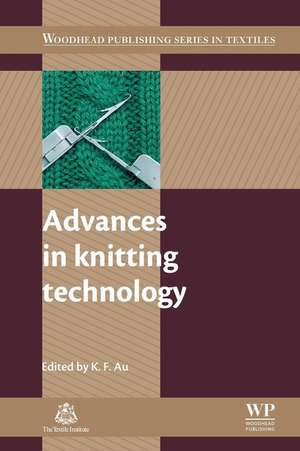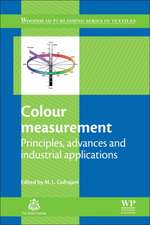Advances in Knitting Technology: Woodhead Publishing Series in Textiles
Editat de K F Auen Limba Engleză Paperback – 18 aug 2016
- Provides both a timely and authoritative reference on developments in knitted fabric production
- Examines different types and suitability of yarns for knitting including the modelling of knitting
- Advances in knitting are explored in a number of different areas such as intelligent yarn delivery systems and current problems and limitations in weft knitted structures for industrial applications
Din seria Woodhead Publishing Series in Textiles
- 9%
 Preț: 947.93 lei
Preț: 947.93 lei - 9%
 Preț: 802.07 lei
Preț: 802.07 lei - 24%
 Preț: 802.53 lei
Preț: 802.53 lei - 9%
 Preț: 1158.65 lei
Preț: 1158.65 lei - 19%
 Preț: 340.02 lei
Preț: 340.02 lei - 24%
 Preț: 1133.92 lei
Preț: 1133.92 lei - 24%
 Preț: 1276.30 lei
Preț: 1276.30 lei - 24%
 Preț: 1132.28 lei
Preț: 1132.28 lei - 24%
 Preț: 949.23 lei
Preț: 949.23 lei - 24%
 Preț: 1162.55 lei
Preț: 1162.55 lei - 9%
 Preț: 1007.18 lei
Preț: 1007.18 lei - 24%
 Preț: 863.89 lei
Preț: 863.89 lei - 24%
 Preț: 1131.24 lei
Preț: 1131.24 lei - 9%
 Preț: 947.06 lei
Preț: 947.06 lei - 9%
 Preț: 1021.10 lei
Preț: 1021.10 lei - 9%
 Preț: 951.37 lei
Preț: 951.37 lei - 24%
 Preț: 1067.05 lei
Preț: 1067.05 lei - 24%
 Preț: 1511.33 lei
Preț: 1511.33 lei - 24%
 Preț: 1131.59 lei
Preț: 1131.59 lei - 9%
 Preț: 865.84 lei
Preț: 865.84 lei - 24%
 Preț: 1195.56 lei
Preț: 1195.56 lei - 23%
 Preț: 911.09 lei
Preț: 911.09 lei - 24%
 Preț: 1027.26 lei
Preț: 1027.26 lei - 29%
 Preț: 845.48 lei
Preț: 845.48 lei - 24%
 Preț: 1232.53 lei
Preț: 1232.53 lei - 9%
 Preț: 1007.18 lei
Preț: 1007.18 lei - 20%
 Preț: 1125.16 lei
Preț: 1125.16 lei - 20%
 Preț: 1185.64 lei
Preț: 1185.64 lei - 9%
 Preț: 1272.93 lei
Preț: 1272.93 lei - 31%
 Preț: 1090.57 lei
Preț: 1090.57 lei - 9%
 Preț: 1156.05 lei
Preț: 1156.05 lei - 24%
 Preț: 1159.97 lei
Preț: 1159.97 lei - 5%
 Preț: 838.79 lei
Preț: 838.79 lei - 39%
 Preț: 803.30 lei
Preț: 803.30 lei - 9%
 Preț: 1092.20 lei
Preț: 1092.20 lei - 29%
 Preț: 1426.03 lei
Preț: 1426.03 lei - 23%
 Preț: 309.98 lei
Preț: 309.98 lei - 20%
 Preț: 883.71 lei
Preț: 883.71 lei - 24%
 Preț: 924.65 lei
Preț: 924.65 lei - 29%
 Preț: 1210.65 lei
Preț: 1210.65 lei - 5%
 Preț: 1001.89 lei
Preț: 1001.89 lei - 9%
 Preț: 726.56 lei
Preț: 726.56 lei - 31%
 Preț: 728.30 lei
Preț: 728.30 lei - 39%
 Preț: 899.39 lei
Preț: 899.39 lei - 9%
 Preț: 986.86 lei
Preț: 986.86 lei - 24%
 Preț: 988.42 lei
Preț: 988.42 lei - 9%
 Preț: 1045.16 lei
Preț: 1045.16 lei - 9%
 Preț: 1167.80 lei
Preț: 1167.80 lei
Preț: 984.44 lei
Preț vechi: 1611.58 lei
-39% Nou
Puncte Express: 1477
Preț estimativ în valută:
188.39€ • 204.57$ • 158.25£
188.39€ • 204.57$ • 158.25£
Carte tipărită la comandă
Livrare economică 15-29 aprilie
Preluare comenzi: 021 569.72.76
Specificații
ISBN-13: 9780081017173
ISBN-10: 0081017170
Pagini: 336
Dimensiuni: 156 x 234 x 18 mm
Greutate: 0.48 kg
Editura: ELSEVIER SCIENCE
Seria Woodhead Publishing Series in Textiles
ISBN-10: 0081017170
Pagini: 336
Dimensiuni: 156 x 234 x 18 mm
Greutate: 0.48 kg
Editura: ELSEVIER SCIENCE
Seria Woodhead Publishing Series in Textiles
Cuprins
Contributor contact details
Woodhead Publishing Series in Textiles
Part I: Introduction: fundamentals of knitting
Chapter 1: Types and suitability of yarns for knitting
Abstract:
1.1 Introduction
1.2 Types of packages
1.3 Structure of cope
1.4 Knitting yarns defects
1.5 Types of knitting yarns: yarns made of natural fibers
1.6 Types of knitting yarns: yarns made of synthetic fibers
1.7 Types of knitting yarns: fancy threads
1.8 Yarns made for special applications
1.9 Methods of joining the polyurethane yarns in composites
1.10 Other yarns for special applications
1.11 Future trends
Chapter 2: The physical properties of weft knitted structures
Abstract:
2.1 Introduction
2.2 Stretch and recovery properties
2.3 Recovery properties
2.4 Dimensional stability
2.5 Creasing
2.6 Thickness and compression properties
2.7 Air permeability
2.8 Thermal properties
2.9 Liquid transfer properties
2.10 Comfort
2.11 Pilling and abrasion
2.12 Knitted fabrics with special properties
2.13 Sources of further information and advice
Chapter 3: Modelling of knitting
Abstract:
3.1 Introduction
3.2 Knitted fabric geometry
3.3 Mechanics of knitted fabric: 2D model
3.4 Mechanics of plain-weft knitted fabrics: 3D model
3.5 Knitted fabric mechanics: energy model
3.6 Knitted fabric pressure on a surface
3.7 Heat and water vapour diffusion in fabrics
3.9 Appendix: initial guess estimates
Part II: Advances in knitting
Chapter 4: Intelligent yarn delivery systems in weft knitting
Abstract:
4.1 Introduction
4.2 Theory of yarn delivery
4.3 Yarn storage and delivery systems on circular knitting machines
4.4 Yarn storage and delivery systems on flat knitting machines
4.5 Future trends
4.6 Sources of further information and advice
Chapter 5: Advances in warp knitted fabric production
Abstract:
5.1 Introduction
5.2 Commercial warp knit machines
5.3 Delaware stitch and modified Delaware stitch Tricot fabrics
5.4 Tricot and Raschel containing spandex
5.5 Key Raschel fabrics containing spandex
5.6 Newly developed constructions with spandex
5.7 Americana and modified Americana Tricots
5.8 Surface interest fabrics
5.9 Milanese fabrics
5.10 Conclusion
5.11 Sources of further information
Chapter 6: Weft-knitted structures for industrial applications
Abstract:
6.1 Introduction
6.2 Current problems and limitations
6.3 Knitting 3D structures using weft-knitting technology
6.4 Directionally oriented structures (DOS) and combined DOS weft-knitted structures
6.5 Weft-knitted multifunctional structures
6.6 Simulating mechanical properties of weft-knitted structures
6.7 Applications
6.8 Future trends
Chapter 7: Advances in circular knitting
Abstract:
7.1 Introduction
7.2 Current problems and limitations of circular knitted structures
7.3 Recent advances in circular knitting
7.4 Structure and properties of circular knitted fabrics
7.5 Applications
7.6 Future trends: smart garments
Chapter 8: Knitted fabric composites
Abstract:
8.1 Introduction
8.2 Types of fibre and yarn used in knitted fabric composites
8.3 Composite preforms
8.4 Knit structures for fabric composites
8.5 Types of matrix materials
8.6 Developments in manufacturing methods for knitted fabric composites
8.7 Mechanical properties
8.8 Applications
8.9 Conclusion
8.10 Acknowledgements
Chapter 9: Quality control in the knitting process and common knitting faults
Abstract:
9.1 Importance of quality knitted fabric
9.2 Knitted fabric quality
9.3 Quality control in the knitting process
9.4 Parameters of knitting control
9.5 Relationship between yarn count and machine gauge
9.6 Examples of quality control mechanisms for circular knitting
9.7 Techniques to reduce knitting faults: online data monitoring system
9.8 Knitted defects
9.9 Conclusion
Part III: Case studies: advanced knitted products
Chapter 10: Women’s apparel: knitted underwear
Abstract:
10.1 Introduction
10.2 Functional requirements of knitted underwear
10.3 Performance evaluation of knitted underwear
10.4 Engineering of knitted underwear fabrics
10.5 Recent developments in knitted underwear fabrics
10.6 Properties of commercially knitted underwear
10.7 Acknowledgements
Chapter 11: Knitted structures for sound absorption
Abstract:
11.1 Introduction
11.2 Acoustic textiles in vehicles
11.3 Sound absorption of plain knitted structures
11.4 Engineering advanced knitted fabrics for sound absorption
11.5 Thick spacer structures
11.6 Dense spacer structures
11.7 Conclusion
11.8 Future trends
11.9 Sources of further information and advice
Chapter 12: Weft-knitted structures for moisture management
Abstract:
12.1 Introduction
12.2 Basics of wetting
12.3 Wicking and absorption
12.4 Experimental liquid take-up
12.5 Future trends
12.6 Sources of further information and advice
Index
Woodhead Publishing Series in Textiles
Part I: Introduction: fundamentals of knitting
Chapter 1: Types and suitability of yarns for knitting
Abstract:
1.1 Introduction
1.2 Types of packages
1.3 Structure of cope
1.4 Knitting yarns defects
1.5 Types of knitting yarns: yarns made of natural fibers
1.6 Types of knitting yarns: yarns made of synthetic fibers
1.7 Types of knitting yarns: fancy threads
1.8 Yarns made for special applications
1.9 Methods of joining the polyurethane yarns in composites
1.10 Other yarns for special applications
1.11 Future trends
Chapter 2: The physical properties of weft knitted structures
Abstract:
2.1 Introduction
2.2 Stretch and recovery properties
2.3 Recovery properties
2.4 Dimensional stability
2.5 Creasing
2.6 Thickness and compression properties
2.7 Air permeability
2.8 Thermal properties
2.9 Liquid transfer properties
2.10 Comfort
2.11 Pilling and abrasion
2.12 Knitted fabrics with special properties
2.13 Sources of further information and advice
Chapter 3: Modelling of knitting
Abstract:
3.1 Introduction
3.2 Knitted fabric geometry
3.3 Mechanics of knitted fabric: 2D model
3.4 Mechanics of plain-weft knitted fabrics: 3D model
3.5 Knitted fabric mechanics: energy model
3.6 Knitted fabric pressure on a surface
3.7 Heat and water vapour diffusion in fabrics
3.9 Appendix: initial guess estimates
Part II: Advances in knitting
Chapter 4: Intelligent yarn delivery systems in weft knitting
Abstract:
4.1 Introduction
4.2 Theory of yarn delivery
4.3 Yarn storage and delivery systems on circular knitting machines
4.4 Yarn storage and delivery systems on flat knitting machines
4.5 Future trends
4.6 Sources of further information and advice
Chapter 5: Advances in warp knitted fabric production
Abstract:
5.1 Introduction
5.2 Commercial warp knit machines
5.3 Delaware stitch and modified Delaware stitch Tricot fabrics
5.4 Tricot and Raschel containing spandex
5.5 Key Raschel fabrics containing spandex
5.6 Newly developed constructions with spandex
5.7 Americana and modified Americana Tricots
5.8 Surface interest fabrics
5.9 Milanese fabrics
5.10 Conclusion
5.11 Sources of further information
Chapter 6: Weft-knitted structures for industrial applications
Abstract:
6.1 Introduction
6.2 Current problems and limitations
6.3 Knitting 3D structures using weft-knitting technology
6.4 Directionally oriented structures (DOS) and combined DOS weft-knitted structures
6.5 Weft-knitted multifunctional structures
6.6 Simulating mechanical properties of weft-knitted structures
6.7 Applications
6.8 Future trends
Chapter 7: Advances in circular knitting
Abstract:
7.1 Introduction
7.2 Current problems and limitations of circular knitted structures
7.3 Recent advances in circular knitting
7.4 Structure and properties of circular knitted fabrics
7.5 Applications
7.6 Future trends: smart garments
Chapter 8: Knitted fabric composites
Abstract:
8.1 Introduction
8.2 Types of fibre and yarn used in knitted fabric composites
8.3 Composite preforms
8.4 Knit structures for fabric composites
8.5 Types of matrix materials
8.6 Developments in manufacturing methods for knitted fabric composites
8.7 Mechanical properties
8.8 Applications
8.9 Conclusion
8.10 Acknowledgements
Chapter 9: Quality control in the knitting process and common knitting faults
Abstract:
9.1 Importance of quality knitted fabric
9.2 Knitted fabric quality
9.3 Quality control in the knitting process
9.4 Parameters of knitting control
9.5 Relationship between yarn count and machine gauge
9.6 Examples of quality control mechanisms for circular knitting
9.7 Techniques to reduce knitting faults: online data monitoring system
9.8 Knitted defects
9.9 Conclusion
Part III: Case studies: advanced knitted products
Chapter 10: Women’s apparel: knitted underwear
Abstract:
10.1 Introduction
10.2 Functional requirements of knitted underwear
10.3 Performance evaluation of knitted underwear
10.4 Engineering of knitted underwear fabrics
10.5 Recent developments in knitted underwear fabrics
10.6 Properties of commercially knitted underwear
10.7 Acknowledgements
Chapter 11: Knitted structures for sound absorption
Abstract:
11.1 Introduction
11.2 Acoustic textiles in vehicles
11.3 Sound absorption of plain knitted structures
11.4 Engineering advanced knitted fabrics for sound absorption
11.5 Thick spacer structures
11.6 Dense spacer structures
11.7 Conclusion
11.8 Future trends
11.9 Sources of further information and advice
Chapter 12: Weft-knitted structures for moisture management
Abstract:
12.1 Introduction
12.2 Basics of wetting
12.3 Wicking and absorption
12.4 Experimental liquid take-up
12.5 Future trends
12.6 Sources of further information and advice
Index

















